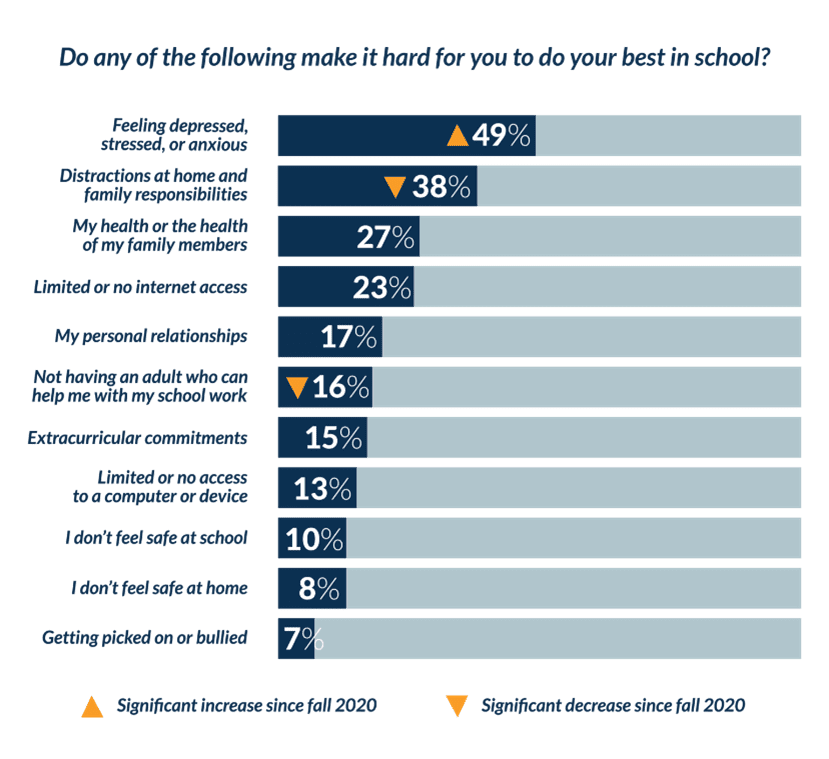
Kameryn Point, AYPF Policy and Programs Associate
While the COVID-19 pandemic has created significant learning gaps for students nationwide, youth impacted by systemic inequities were disproportionately affected, which exacerbated disparities that already existed within our education systems. Educators are now challenged to meet students where they are, while simultaneously addressing the learning gap created by the pandemic.
- 49% of students who responded to a survey from YouthTruth reported that feeling depressed, stressed, or anxious created obstacles to their learning and that while mental health needs rose through the pandemic, fewer students felt that they had an adult at school with whom they could talk to about their stress.
- Black, Indigenous, and Latinx students were more likely than their white classmates to have limited or no access to necessary technology for remote learning (computers and internet).
- Additionally, the percentage of high school seniors who reported that they plan to attend a four-year college dropped to below 50% as plans of going to college have been derailed by family, financial, and health complications.

Courtesy of https://youthtruthsurvey.org/students-weigh-in-part3/
While reopening schools has presented many challenges, there is hope. This period of reopening can serve as a time for educational re-invention that has been desperately needed even prior to the pandemic.
It is crucial that schools re-engage and support students by collecting and analyzing data, working with community partners to provide wraparound supports, and adopting intervention strategies to address learning gaps such as intensive tutoring programs, expanded summer learning opportunities, and social-emotional learning programs. Schools around the country have been granted an historic $130 billion from the federal government to support schools safely reopening and addressing the needs of students, including $122 billion through the American Rescue Plan’s Elementary and Secondary School Emergency Relief Fund (ARP ESSER), which “supports efforts to get students back in the classroom safely for in-person learning, to safely keep schools open once students are back, and to address the social, emotional, mental health, and academic needs of all students.”
Not only are the federal funds of the American Rescue Plan historic in their amount, but also in their intent, as many of the funds are explicitly devoted to support youth impacted by systemic inequities.
- For example, the ARP ESSER requires that high-poverty school districts and schools be protected from funding cuts.
- The Department of Education has dedicated all $800 million in American Rescue Plan funds to identify and address the needs of students experiencing homelessness, including providing wraparound services and support such as after school care and mental health services.
- The American Rescue Plan devotes nearly $2.6 billion in grants to states to support elementary and secondary education students with disabilities.
- $535 million from the American Rescue Plan is being used by The Bureau of Indian Education (BIE) to support 183 BIE-funded K-12 schools and Native youth.
 The disruption of traditional schooling in conjunction with an unprecedented $130 billion of federal funds has presented an opportunity to transform schooling into a more equitable and holistic experience for students than before the pandemic. “Going back to normal” is no longer an option as many students have experienced life-altering trauma during the pandemic such as financial and food insecurity, death of loved ones, and isolation. Furthermore, “normal” would continue to deepen the pre-existing disparities within our education systems that impact students of color, low-income students, and students with disabilities. During this period of flexibility and creativity, schools can innovatively address the needs of their most vulnerable students, while working to dismantle dangerous practices and systems that were integrated into their pre-pandemic model of schooling.
The disruption of traditional schooling in conjunction with an unprecedented $130 billion of federal funds has presented an opportunity to transform schooling into a more equitable and holistic experience for students than before the pandemic. “Going back to normal” is no longer an option as many students have experienced life-altering trauma during the pandemic such as financial and food insecurity, death of loved ones, and isolation. Furthermore, “normal” would continue to deepen the pre-existing disparities within our education systems that impact students of color, low-income students, and students with disabilities. During this period of flexibility and creativity, schools can innovatively address the needs of their most vulnerable students, while working to dismantle dangerous practices and systems that were integrated into their pre-pandemic model of schooling.


